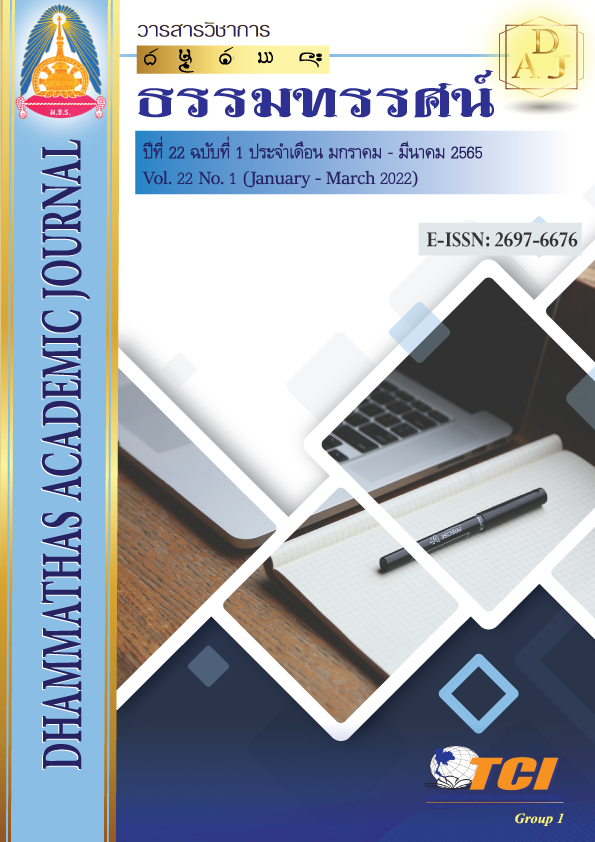A Study of the Value Chain of Coffee Processes for the Strength and Quality of Life of Ban Rak Thai Community, Chomphu Sub-district, Noen Maprang District, Phitsanulok Province
Main Article Content
Abstract
The objective of this research was to investigate 1) upstream activities including knowledge management and empowering farmers, managing to increase productivity and improve coffee bean quality, studying and designing coffee bean harvesters, 2) midstream activities including the development of dietary supplements and cosmetics from coffee bean shell extract, the development of bakery products from waste ingredients in the coffee production process, and 3) downstream activities including creating an identity from coffee beans to develop market potential. The research was divided into two parts: quantitative and qualitative research. Data collection was conducted through interviews from samples, data analysis through content analysis, and inductive analysis.
The major findings revealed as follows:
1. In terms of upstream activities, knowledge management empowered coffee growers to be effective, had steps to study problems and obstacles to find contributing factors to completion and contributes to the creation of local curriculum for Rak Thai Rom Klao Uppatham School, creating coffee growing skills learning for local youth. The results of the experiment using chitosan and scale fertilizer contributed to an increase in the yield of Robusta coffee beans, allowing for more consistent flowering, and studies have studied the machine being designed coffee bean harvester, convenient to move, small, lightweight, and convenient for mountain use.
2. In terms of midstream activities, the shell of coffee beans was extracted to obtain high phenolic and flavonoids to develop into hand care products.In addition, Took the coffee bean shell extract powder to develop into a drink, melted herbs, brewed hot.When processing coffee bean shell powder was used as a mixture of bakery products such as cookies, brownies, bread, cakes, pie cups, etc.
3. In terms of downstream activities, finding the identity of the coffee name, Doi Phao Thai Coffee, coffee taste was unique and good identity, and perceived the identity of the coffee through the media affected the decision to buy Doi Phao Thai Coffee bean products.
Article Details

This work is licensed under a Creative Commons Attribution-NonCommercial-NoDerivatives 4.0 International License.
เพื่อให้เป็นไปตามกฎหมายลิขสิทธิ์ ผู้นิพนธ์ทุกท่านต้องลงลายมือชื่อในแบบฟอร์มใบมอบลิขสิทธิ์บทความ ให้แก่วารสารฯ พร้อมกับบทความต้นฉบับที่ได้แก้ไขครั้งสุดท้าย นอกจากนี้ ผู้นิพนธ์ทุกท่านต้องยืนยันว่าบทความ ต้นฉบับที่ส่งมาตีพิมพ์นั้น ได้ส่งมาตีพิมพ์เฉพาะในวารสาร วิชาการธรรม ทรรศน์ เพียงแห่งเดียวเท่านั้น หากมีการใช้ ภาพหรือตารางของผู้นิพนธ์อื่นที่ปรากฏในสิ่งตีพิมพ์อื่นมาแล้ว ผู้นิพนธ์ต้องขออนุญาตเจ้าของลิขสิทธิ์ก่อน พร้อมทั้ง แสดงหนังสือที่ได้รับการยินยอมต่อบรรณาธิการ ก่อนที่บทความจะได้รับการตีพิมพ์References
ชุติมณฑน์ พลอยประดับ, พุทธพร เจียมศุภกิตต์ และ นิรมล ปัญญ์บุศยกุล. (2553). ฤทธิ์การต้านออกซิเดชั่นของส่วนต่างๆ ของผลกาแฟอาราบิก้า และกากกาแฟ. ว. วิทยาศาสตร์เกษตร, 41(3/1)(พิเศษ), 577-580.
ธิดารัตน์ เมธาวรากุล และคณะ. (2560). อิทธิพลของการตัดแต่งกิ่งและการให้ปุ๋ยต่อผลผลิตและคุณภาพเมล็ดกาแฟอาราบิก้าที่ปลูกในสถานีวิจัยเพชรบูรณ์. วารสารวิทยาศาสตร์เกษตร, 48(2), 284-296.
นุชนาฏ ตันวรรณ และคณะ. (2560). ผลของไคโตซานเพื่อเพิ่มผลผลิตและปริมาณสารทุติยภูมิในข้าว. แก่นเกษตร, 45(1), 1322-1327.
ณฐิตากานต์ ปินทุกาศ และพงษ์ศักดิ์ อังกสิทธิ์. (2560). รูปแบบและกระบวนการส่งเสริมการปลูกกาแฟอราบิก้าในพื้นที่ โครงการหลวงและโครงการพัฒนาพื้นที่สูงแบบโครงการหลวง. แก่นเกษตร, 45(1), 521-526.
ทํานอง ภูเกิดพิมพ์. (2551). แนวคิดการบริหารแบบมีส่วนร่วมในการจัดการศึกษาของชุมชน. เข้าถึงได้จาก http://www.thaischool.net/view_tj.php?ID=1203
ปรีชา อานันท์รัตนกุล. (2562). รายงานโครงการวิจัยพัฒนาเครื่องจักรกลหลังการเก็บเดี่ยวและแปรรูปกาแฟระดับเกษตรกร. กรุงเทพฯ: กรมวิชาการเกษตร.
พัชนี ตูเล๊ะ. (2561). ปัจจัยที่ส่งเสริมและพัฒนาความเข้มแข็งในจังหวัดนราธิวาส. วารสารมหาวิทยาลัยศิลปากร, 11(2), 3560-3575.
พันธุ์อาจ ชัยรัตน์. (2547). บทนำเบื้องต้นของการจัดการนวัตกรรม. การจัดการนวัตกรรมสำหรับผู้บริหาร. กรุงเทพฯ: สำนักงานนวัตกรรมแห่งชาติ กระทรวงวิทยาศาสตร์และเทคโนโลยี.
พระมหาเทวประภาส มากคล้าย, บุญทัน ดอกไธสง และบุษกร วัฒนบุตร. (2559). พุทธบูรณาการเพื่อการพัฒนาสมรรถนะองค์การบริหารส่วนตำบล ในการเสริมสร้างชุมชนเข้มแข็ง. Veridian E-Journal, Silpakorn University, 9(3), 615-630.
ไพบูลย์ วัฒนศิริธรรม. (2553). แผนที่ความดี ฉบับไพบูลย์ วัฒนศิริธรรม. กรุงเทพฯ: มติชน.
ภูพงษ์ พงษ์เจริญ. (2556). การพัฒนาโปรแกรมช่วยแก้ปัญหาการจัดเรียงกล่องผลิตภัณฑ์ลงในตู้สินค้าด้วยระบบภูมิคุ้มกัน. พิษณุโลก: มหาวิทยาลัยนเรศวร.
ระวิวรรณ แก้วอมตวงศ์ และทรงพร จึงมั่นคง. (2549). ฤทธิ์ต้านอนุมูลอิสระ DPPH และปริมาณสารฟีนอลิกรวมของสารสกัดพืช สมุนไพรไทยบางชนิด. อุบลราชธานี: คณะเภสัชศาสตร์ มหาวิทยาลัยอุบลราชธานี.
วินัย ทองภูบาล. (2562). การพัฒนาหลักสูตรท้องถิ่นเรื่อง ข้าว เพื่อความมั่นคงทางอาหารของโรงเรียนหินดาดวิทยา โดยใช้การวิจัยเชิงปฏิบัติการแบบมีส่วนร่วม. วารสารวิทยาลัยนครราชสีมา, 13(3), 139-150.
สถาบันพัฒนาองค์กรชุมชน (องค์การมหาชน). (2564). คู่มือการบริหารโครงการ การสนับสนุนการพัฒนาชุมชนท้องถิ่นและขบวนองค์กรชุมชน ประจำปีงบประมาณ พ.ศ. 2564. กรุงเทพฯ: สถาบันพัฒนาองค์กรชุมชน (องค์การมหาชน) กระทรวงการพัฒนาสังคมและความมั่นคงของมนุษย์.
สถาบันวิจัยพืชสวน กรมวิชาการเกษตร. (2559). การลดต้นทุนการผลิตพืชสวน (ไม้ผล) เพื่อเพิ่มขีดความสามารถให้แก่เกษตรกรไทย. กรุงเทพฯ: สถาบันวิจัยพืชสวน.
สำนักงานนวัตกรรมแห่งชาติ. (2550). สุดยอดนวัตกรรมไทย. กรุงเทพฯ: สำนักงานนวัตกรรมแห่งชาติ กระทรวงวิทยาศาสตร์และเทคโนโลยี.
สังคม เตชะวงค์เสถียร. (2547). สรีรวิทยาของพืชสวน. ขอนแก่น: คณะเกษตรศาสตร์มหาวิทยาลัยขอนแก่น.
โอภา วัชรคุปต์. (2550). สารต้านอนุมูลอิสระ. (พิมพ์ครั้งที่ 2). กรุงเทพฯ: นิวไทยมิตร.
George, F. G. (1979). Development Administration: Concepts, Goals, Methods, Madison. Wisconsin: The University of Wisconsin Press.
Mazza, G., Miniati, E. (1993). Anthocyanins in fruits, vegetables, and grains. Boca Raton: CRC Press.
Kotler. (1997). Marketing management: analysis, planning implementation and control. (9 th ed). New Jersey: Asimmon & Schuster.
Porter, M. E. (1980). Competitive Strategy: Techniques for Analyzing Industries and Competitors. New York: Free Press.
Mirón - Mérida et al . (2019). Valorization of coffee parchment waste (Coffeaarabica) as a source of caffeine and phenolic compounds in antifungal gellan gum films. LWT - Food Science and Technology, (101), 167-174.
Panusa, A., et al. (2017). UHPLC-PDA-ESI-TOF/MS metabolic profiling and antioxidant capacity of arabica and robusta coffee silverskin: Antioxidants vs phytotoxins. Food Research International, (99), 155-165.
